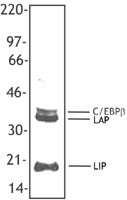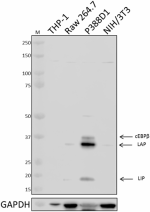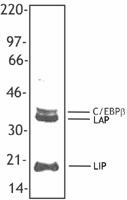- Clone
- 1H7 (See other available formats)
- Regulatory Status
- RUO
- Other Names
- CCAAT/enhancer-binding protein beta, Alpha-1-acid glycoprotein/enhancer binding protein, Interleukin 6-dependent DNA-binding protein (IL-6DBP), Nuclear factor of interleukin 6 (NF-IL6), Liver-enriched transcriptional activator protein (LAP)
- Isotype
- Mouse IgG2a, κ
- Ave. Rating
- Submit a Review
- Product Citations
- publications

-

P388D1 (IL-1) cell nuclear extract was resolved by electrophoresis, transferred to nitrocellulose and probed with anti-C/EBP ß antibody (Clone 1H7). Proteins were visualized using a goat anti-mouse secondary antibody conjugated to HRP and a chemiluminescence system.
| Cat # | Size | Price | Quantity Check Availability | Save | ||
|---|---|---|---|---|---|---|
| 606203 | 25 µg | 118€ | ||||
| 606204 | 100 µg | 244€ | ||||
C/EBP β (also known as CCAAT/enhancer-binding protein beta, interleukin 6-dependent DNA-binding protein, and nuclear factor of interleukin 6 [NF-IL6]) is a member of the basic leucine zipper C/EBP transcription factor family. C/EBP has three isoforms that include C/EBPβ, LAP, and LIP (35 kD, 32 kD, and 20 kD, respectively). This protein is localized in the nucleus and functions as a transcription factor in immune, inflammatory, acute-phase, cytokine, collagen type I gene expression. It is upregulated by growth hormones and has been shown to interact with CEBP-α, CEBP-δ, CEBP-γ, CEBP-ε, and CEBP-ζ. The C/EBP β protein can be modified by phosphorylation and ubiquitination. The 1H7 monoclonal antibody has been reported to be useful for Western blotting, immunoprecipitation, and immunofluorescence of mouse and rat C/EBP β, LIP, and LAP isoforms. The 1H7 antibody does not recognize human C/EBP β, LIP or LAP.
Product DetailsProduct Details
- Verified Reactivity
- Mouse, Rat
- Antibody Type
- Monoclonal
- Host Species
- Mouse
- Immunogen
- Recombinant LIP
- Formulation
- Phosphate-buffered solution, pH 7.2, containing 0.09% sodium azide.
- Preparation
- The antibody was purified by affinity chromatography, and conjugated with biotin under optimal conditions.
- Concentration
- 0.5 mg/mL
- Storage & Handling
- The antibody solution should be stored undiluted between 2°C and 8°C. Do not freeze.
- Application
-
WB - Quality tested
- Recommended Usage
-
Each lot of this antibody is quality control tested by Western blotting. Western blotting, suggested working dilution(s): Use 5 µg antibody per 5 mL antibody dilution buffer for each mini-gel. It is recommended that the reagent be titrated for optimal performance for each application.
- Application Notes
-
Recognizes three mouse isoforms: C/EBP ß, LAP, LIP. Does not cross-react with human.
- Application References
-
- Su, et al. 2003. J. Biol. Chem. 278:51150. (ChIP)
- Blidner AG, et al. 2015. J Immunol. 194:3452. PubMed
- RRID
-
AB_572024 (BioLegend Cat. No. 606203)
AB_572025 (BioLegend Cat. No. 606204)
Antigen Details
- Structure
- C/EBP transcription factor family, basic leucine zipper, dimer. Isoforms C/EBPβ, LAP, LIP, approximately 35 kD, 32 kD, 20 kD, respectively
- Distribution
-
Nuclear
- Function
- Transcription factor in immune, inflammatory, acute-phase, cytokine, collagen type I genes
- Interaction
- CEBP-α, CEBP-β, CEBP-δ, CEBP-γ, CEBP-ε, CEBP-ζ
- Modification
- Phosphorylation, Ubiquitination
- Biology Area
- Cell Biology, Transcription Factors
- Molecular Family
- Nuclear Markers
- Antigen References
-
1. Chang C, et al. 1990. Mol. Cell Biol. 10:6642.
2. Eaton E, et al. 2001. J. Cell Physiol. 189:91.
3. Piwien-Pilipuk G, et al. 2002. J. Biol. Chem. 277:44557.
4. Hattori T, et al. 2003. Oncogene. 22:1273. - Regulation
- Growth hormone
- Gene ID
- 12608 View all products for this Gene ID 25301 View all products for this Gene ID
- UniProt
- View information about C/EBP beta on UniProt.org
Related Pages & Pathways
Pages
Related FAQs
- How many biotin molecules are per antibody structure?
- We don't routinely measure the number of biotins with our antibody products but the number of biotin molecules range from 3-6 molecules per antibody.
Other Formats
View All C/EBP β Reagents Request Custom Conjugation| Description | Clone | Applications |
|---|---|---|
| Purified anti-C/EBP β (3 isoforms C/EBP β, LAP, LIP) | 1H7 | WB,ChIP,IP,ICC |
| Biotin anti-C/EBP β (3 isoforms C/EBP β, LAP, LIP) | 1H7 | WB |
Compare Data Across All Formats
This data display is provided for general comparisons between formats.
Your actual data may vary due to variations in samples, target cells, instruments and their settings, staining conditions, and other factors.
If you need assistance with selecting the best format contact our expert technical support team.
-
Purified anti-C/EBP β (3 isoforms C/EBP β, LAP, LIP)

Total cell lysates (15 µg total protein) from THP-1 (negativ... -
Biotin anti-C/EBP β (3 isoforms C/EBP β, LAP, LIP)

P388D1 (IL-1) cell nuclear extract was resolved by electroph...
 Login / Register
Login / Register 









Follow Us